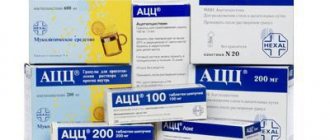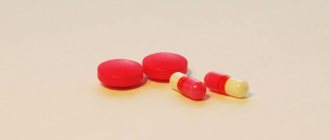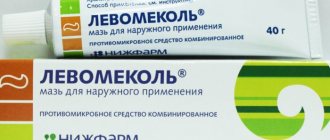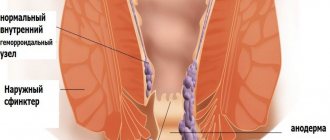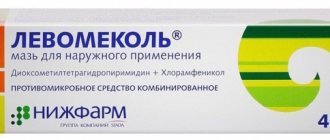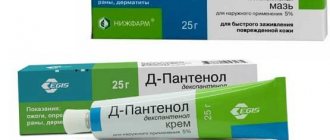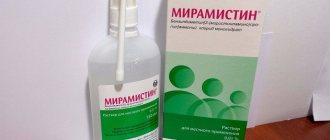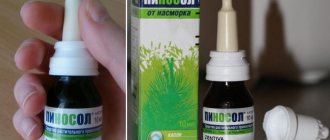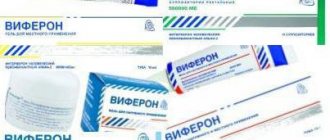11/06/2018 Category: Medicines and vitamins Author: Lyudmila
Levomekol ointment is an effective and popular anti-inflammatory and wound healing agent. However, the effect of any drug on the body during pregnancy requires special attention. Is it possible to use the drug while pregnant and how to do it correctly?
- Use during pregnancy
When and how to use
- Possible harm and contraindications
- Table: how to replace Levomekol ointment
Photo gallery: analogues of Levomekol
Levomekol - release form and composition of the drug
Levomekol is a complex antibacterial drug for external use. Its action is aimed at disinfecting the skin lesion and rapid cell regeneration. This is a popular drug in the form of a white ointment, in tubes of 20,30,40 grams, produced by many pharmaceutical companies.
The main components included in Levomekol:
- Levomycetin (chloramphenicol) is the main active ingredient of the drug. Being a broad-spectrum antibiotic, it suppresses the vital activity of most infectious pathogens and destroys pathogenic microflora.
- Methyluracil. A substance that has a strong immunostimulating effect. It has a positive effect on the restoration and regeneration of tissue in the affected area, and blocks the source of inflammation.
Operating principle of Levomekol
After external application of the ointment to the surface of the skin, its active components actively penetrate into the deepest layers of the epidermis and provide the following processes:
- The ointment quickly heals damaged areas of the skin in soft tissues, promotes active regeneration and healing of the skin, and renewal of its dead areas.
- Thanks to the rapid removal of intercellular fluid from the wound, toxins, pus, and residual waste products of pathogenic microorganisms are removed, and tissue swelling disappears.
- The active substance is an antibiotic, relieves the inflammatory process, destroying and having a detrimental effect on pathogenic microbes that cause suppuration and inflammation of the skin.
- Levomekol has a positive effect on the immune system, increasing the body's resistance. Allows you to resist infection at the cellular level, helps accelerate the natural synthesis of interferon.
The effect of Levomekol on the body of a pregnant woman and fetus
The drug is available in the form of a water-based ointment. Levomekol is a combination medicine intended for external use only.
Antimicrobial and anti-inflammatory effects are due to the active components of the ointment:
- Levomycetin (the first most important component). The international name is chloramphenicol. The substance is a broad-spectrum antibiotic and has a bacteriostatic effect on the infectious pathogen. By disrupting the protein synthetic process in microorganisms, it provokes a stop in their growth and reproduction. Levomycetin that enters the general bloodstream is able to penetrate the hematoplacental barrier, exerting a toxic effect on the developing fetus. However, the use of Levomekol during pregnancy is safe - due to the fact that the ointment is applied topically, no negative effects will be observed.
- Methyluracil . First of all, it has a pronounced immunostimulating effect. Accelerates the process of tissue regeneration in areas of damage by stimulating the proliferation (reproduction) of its own cells. The presence of methyluracil in the ointment does not make Levomekol dangerous in the early stages of pregnancy.
- Ethylene glycol . Serves as the basis for an ointment, stabilizing a mixture of 1 or two active ingredients. There is no question as to whether dangerous undesirable effects can be expected from it, since it is not an active ingredient.
The instructions for use indicate that the effect of Levomekol on the body of a pregnant woman does not have any distinctive features. The gestating fetus is also not affected by the drug due to local application. Is it possible to use Levomekol during pregnancy? To obtain a reliable answer, it is necessary to fully study the description of the drug.
Levomekol ointment - indications and contraindications for use
Levomekol is actively used for many common dermatological skin problems, such as:
- Effectively heals wounds resulting from severe thermal or chemical burns, even of a high degree, and accelerates the healing of the epidermis.
- Promotes rapid healing of infected areas on the body, destroying all infectious agents, and is used for abrasions and deep cuts.
- Accelerates the regeneration of the skin when opening a water callus.
- It is used to eliminate a number of purulent-inflammatory pathological processes and promotes natural cleansing of the wound from pus.
- It is used in the treatment of furunculosis and acne, weeping wounds with eczema, and promotes the healing of hemorrhoidal fissures in hemorrhoids.
- Heals trophic ulcers, Levomekol is effective for people with diabetic foot syndrome.
- The ointment is used to treat bedsores in bedridden patients.
- Levomekol is used for rapid healing of postoperative sutures to prevent their suppuration and infection.
The drug has no contraindications, except for the presence of individual intolerance to the main components of the ointment.
Features of the use of Levomekol ointment at different stages of pregnancy
First trimester of pregnancy:
The placenta is forming. The baby's main internal organs and systems are formed. During this period, Levomekol is not recommended to be used. When diagnosing diseases when the use of ointment is necessary, doctors prescribe the remedy. This is advisable if the health of the expectant mother is at risk and exceeds the risk to the baby.
Pathogenic bacteria, microorganisms, and pus can infect the mother’s body and cause irreparable harm to the fetus. The danger may lie in the appearance of an unwanted allergy when using the ointment for the first time. Chloramphenicol in ointment is not capable of causing abortion and promoting the development of fetal abnormalities.
II trimester of pregnancy:
The placenta is fully formed, the baby’s internal organs are laid, the fetus is growing and developing rapidly, and movement begins to be felt. A woman’s belly grows and her center of gravity shifts. Any cold is dangerous, many medications are prohibited as they can harm the baby. Levomekol is not one of them. The medicine has a positive effect on wound healing and does not affect the fetus or the female body.
III trimester of pregnancy:
The fetus gains weight, prepares for life outside the mother’s body, its systems and organs improve, sense organs begin to function, and reflexes develop. With the growth of the abdomen and frequent constipation, the veins of the rectum may become inflamed, varicose veins and other complications may appear.
Is it possible to use Levomekol ointment during pregnancy?
According to the instructions, Levomekol ointment can be prescribed to patients during pregnancy, despite the fact that it contains an antibiotic. Levomekol is used only for external use, therefore it is safe for both a pregnant woman and her baby. The active components of the ointment, penetrating the epidermis, do not enter the bloodstream and do not have a detrimental effect on the development of the fetus.
According to most doctors, the danger of infection and wound suppuration is much more dangerous for the condition of a pregnant woman than the external use of ointment. Pus and pathogenic microorganisms can cause irreparable harm to the entire body.
Levomekol: contraindications during pregnancy
The ointment is not recommended for use by pregnant women in the following situations:
- If the expectant mother has an intolerance to one of the active ingredients of the drug, with increased sensitivity and allergic rashes on the skin after its use: itching, burning, swelling of the skin at the site of application of the ointment.
- It is worth abstaining or obtaining permission from your attending physician to use Levomekol in the 1st trimester of pregnancy, during the formation of important fetal organs.
Composition and properties of Levomekol ointment
The ointment first appeared in pharmacies back in Soviet times and is still in demand. This remedy is traditionally produced in the form of an ointment and is used to treat various skin lesions - fungal, purulent, burns, postoperative sutures and others. The ointment has a whitish or yellowish tint and is stored in the refrigerator, which ensures a thick consistency and a long shelf life. When applied to the skin, the consistency of Levomekol becomes more liquid, which facilitates easy penetration into the tissues and cells of the body.
When heated on the skin, Levomekol ointment becomes liquid
This drug is combined, contains two active ingredients, has both an antibacterial and wound-healing effect, and promotes skin regeneration.
Components of the drug:
- chloramphenicol. An antibacterial component, popularly known as levomecitin. It has a detrimental effect on pathogenic bacteria, blocking the synthesis of proteins in microorganisms, which leads to their death and the cessation of the inflammatory process on the skin;
- methyluracil. This substance stimulates the production of interferon in the body and has a regenerating effect on tissues. Local immunity increases, cell division occurs more actively, healing occurs faster than without exposure to methyluracil;
- polyethylene oxides. Excipients, the purpose of which is to facilitate the penetration of the drug into tissues, relieve swelling, and remove excess intercellular fluid.
The ointment is based on water, so when applied there is usually no burning, pain or other unpleasant sensations. The risk of damaging the skin even more, burning or injuring is also minimal.
When is Levomekol prescribed during pregnancy?
Levomekol ointment is often prescribed to expectant mothers for the treatment of the following ailments that accompany pregnancy:
- The drug is most effective for drawing out pus from weeping wounds and trophic ulcers that occur in diabetics; it is used in the form of sterile gauze compresses.
- Excellent healing of boils, various purulent rashes, acne, promotes rapid healing of the skin when calluses are opened.
- Relieves inflammation and infection of purulent wounds in the oral cavity, used for dental problems (stomatitis, periodontal disease).
- Levomekol is used for otitis and inflammation of the external ear, with complications in the form of suppuration. It is used in the form of a flagellum soaked in ointment, which is placed in the ear canal. Levomekol should be carefully introduced into the ear during pregnancy so as not to injure the ear canal.
- The drug is successfully used in the treatment of many ENT diseases as prescribed by a doctor. Levomekol is used during pregnancy for a runny nose, and for sinusitis in the form of tourniquets in the nasal passages. The drug effectively removes mucus and purulent crusts in the nasal cavity. Before using tourniquets with Levomekol in the nose during pregnancy, you should rinse it using a soap solution.
- Levomekol is prescribed for chronic hemorrhoids during pregnancy and during exacerbation of the disease. The ointment also serves as an excellent prophylactic against hemorrhoids and accelerates the healing of microcracks in the anus during constipation. Before using Levomekol for hemorrhoids during pregnancy, you should definitely visit a proctologist.
- Doctors often prescribe ointment for the treatment of infectious gynecological diseases. Levomikol is used in gynecology in the form of tampons in the vagina, impregnated with a drug, for cervical erosion, inflammatory processes in the ovaries and tubes, for bacterial vaginosis, vulvovaginitis.
Levomekol during pregnancy: instructions
- Levomkol is an ointment for topical use, applied to the affected areas of the skin in a small layer, 3-4 times a day, until the pregnant woman’s condition improves.
- The duration of treatment with Levomekol is no more than 7-10 days and is agreed with the attending physician. By this time, signs of infection and tissue suppuration should stop.
- Despite the safety of Levomekol for the fetus and the body of a pregnant woman, it is impossible to use the ointment independently, without the consent of a doctor.
- To treat large areas and deep wounds, sterile compresses with ointment are used.
- Levomekol is used during pregnancy only externally; if it gets into the mouth, the drug can negatively affect the fetus, so special care should be taken when using it.
- In the treatment of hemorrhoids, ENT and gynecological diseases, tampons soaked in the drug are used, which are inserted into the vagina or anus.
Is it possible to overdose on Levomekol during pregnancy?
Cases of overdose of treatment with Levomekol have not been officially registered. The drug is safe for the body, as it is used only for external use. When using it, you must adhere to the recommended dosage and duration of treatment, agreed with your doctor.
Side effects from Levomekol
If you are hypersensitive to the drug, an allergic reaction may occur on the skin: itching, burning, tissue swelling. If one of the listed symptoms appears, you should stop using the drug.
Instructions for use
Levomekol ointment is used in the same way as usual. It is used externally and locally. Take a sterile napkin or swab and apply it to the damaged area. Of course, due to certain physiological characteristics, pregnant women may have certain problems applying the napkin on their own. And therefore, for example, Levomekol for hemorrhoids during pregnancy must be used with outside help.
The important point is that it is necessary to treat any wound with this composition by applying it regularly, and not occasionally. You must completely clean the wound of purulent accumulations. To do this, bandage the affected area of the body daily. Note that the ointment can be considered an effective first aid when it comes to treating burns and boils.
Levomekol during pregnancy - analogues
Levomekol ointment has several analogues, similar in composition and mechanism of action. Many pharmaceutical companies offer chloramphenicol ointment, which differ in name and price. In some cases, if an allergy to Levomekol occurs, the doctor may replace this ointment and prescribe the following antibacterial drugs to the patient:
- Levosin.
- Protegentin.
- Streptonitol.
Analogue drugs
In cases where the use of Levomekol is impossible for some reason (it is not available in the pharmacy or a pregnant woman is hypersensitive to the drug), it is worth choosing a suitable analogue. Medicines may have different active ingredients, but identical indications for use, or be similar in composition, but differ in the presence of additional components. In any case, the doctor must choose the appropriate medication during pregnancy.
Table: how to replace Levomekol ointment
| Drug name | Release form | Composition (active ingredients) | Purpose | Contraindications | Features of the drug |
| Levomethyl | Ointment |
| Purulent wounds in the 1st (purulent-necrotic) phase of the wound process | Hypersensitivity. According to the instructions, during pregnancy the drug is used with caution after comparing the risks for the mother and fetus. | Identical to Levomekol in composition and mechanism of action |
| Levosin |
| Hypersensitivity | The composition is supplemented with a bacteriostatic antibiotic and anesthetic | ||
| VoskoPran levomekol dressing | Bandage |
|
| Levomekol ointment is applied to the surface of the coating | |
| Streptonitol | Ointment |
|
|
| Antibiotic in combination with an antimicrobial component |
| Balsamic liniment (according to Vishnevsky) |
|
| Individual intolerance to components | Functional analogue, contains chemical and natural components |
Photo gallery: analogues of Levomekol
VoskoPran dressings are distinguished by their reliability and safety
Balsamic liniment (according to Vishnevsky) has been popular since Soviet times
Streptonitol is low cost
Levosin heals damaged skin and relieves pain
Levomethyl is a structural and functional analogue of Levomekoli
Levomekol during pregnancy: reviews
As a rule, treatment with Levomekol has positive reviews from patients. Many pregnant women recommend using the ointment to treat gynecological problems and hemorrhoids, considering it one of the most effective among other local drugs. Recovery occurs quickly, the drug has virtually no contraindications and is absolutely safe.
Karina: “Levomekol helped me get rid of a boil, which was causing me a lot of problems. The ointment quickly drew out the pus, the wound healed quickly and disappeared almost without a trace. The treatment lasted about 5 days.”
Nastya: “I have been suffering from chronic hemorrhoids for a long time, and I especially felt all its delights during pregnancy. The doctor advised using tampons with Levomekol in the anus to reduce pain and burning. I felt an improvement after the first administration of the drug, gradually the cracks and knots resolved. I wasn’t worried about the baby’s health, as I was confident in the safety of Levomekol.”
Ksenia: “Levomekol is always in my first aid kit. I often use it to disinfect abrasions, burns, wounds, and relieve inflammation in the affected area. I treat the wound 3 times a day and after a few days the skin is restored.”
To summarize, I would like to note that Levomekol is an effective and safe treatment for dermatological and other problems during pregnancy. However, expectant mothers, before using the drug to solve their problem, should consult a doctor to avoid unforeseen side effects.
Levomekol ointment for hemorrhoids
Treatment of hemorrhoids with Levomekol ointment is practiced only during periods of exacerbation. It relieves inflammation, kills pathogenic bacteria, and accelerates the healing of damaged tissue. In this case, Levomekol is applied for 10 days. Every day you need to lubricate the anus before going to bed.
If the inflamed hemorrhoid is located outside, then the ointment is applied to a clean gauze pad and applied to it. The internal one is treated in the same way, but with the help of a tampon, which is inserted into the rectum. Before applying Levomekol, wash the perineum and anus with clean water and soap, then wipe dry with a clean napkin.
The effect of using Levomekol can be felt quite quickly: the inflamed mucous membrane returns to normal, anal fissures heal, pain, itching, burning and swelling disappear.
Remember! Levomekol ointment is not an antihemorrhoidal agent. Once the inflammation has subsided, contact your doctor for further treatment instructions.
To continue treatment, suppositories and ointments are usually prescribed: Proctosedyl, Gepatrombin G, Relief, as well as Troxevasin, Troxerutin and others.
Pharmacological action of Levomekol
Thanks to the combined effects of the components, Levomekol successfully copes with various tissue damages.
The mechanism of action of the ointment is as follows:
- elimination of pathogenic microorganisms in areas of tissue damage;
- restoration of the skin;
- stimulation of local immunity;
- regulation of the process of renewal of dead areas of the epidermis and surface tissues;
- reduction of swelling of damaged areas;
- removal of pus and other elements of the vital activity of pathogenic microorganisms;
- stopping the inflammatory process.
